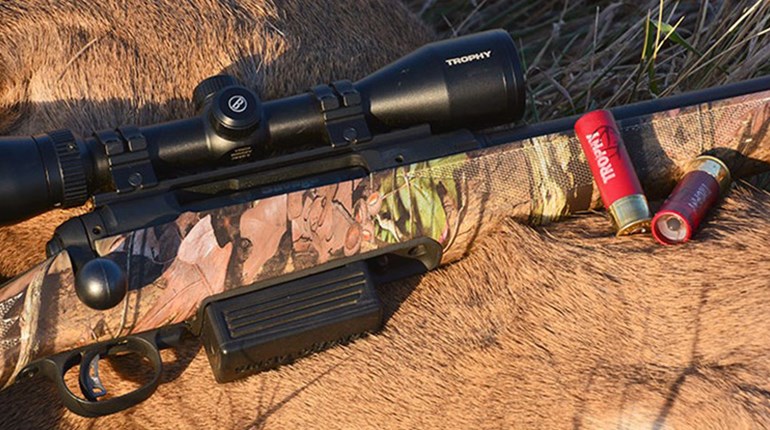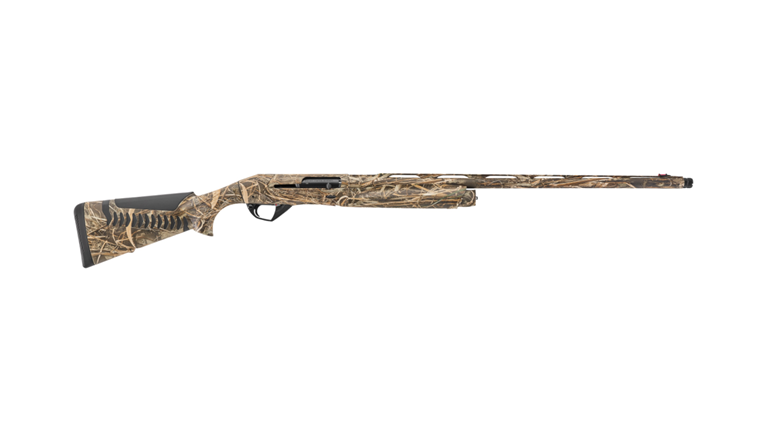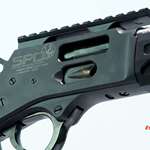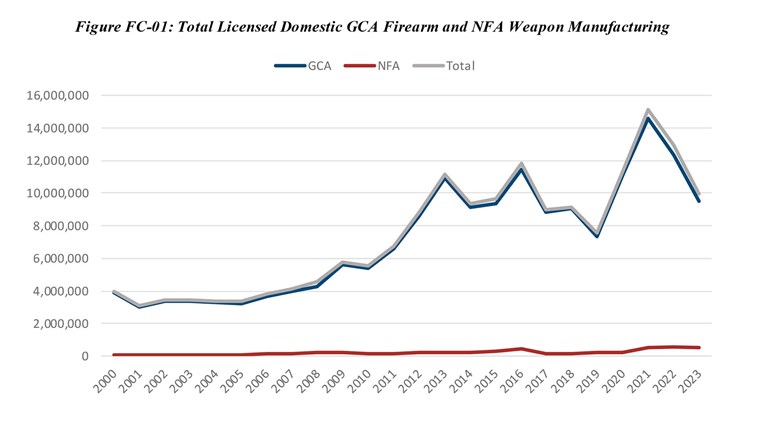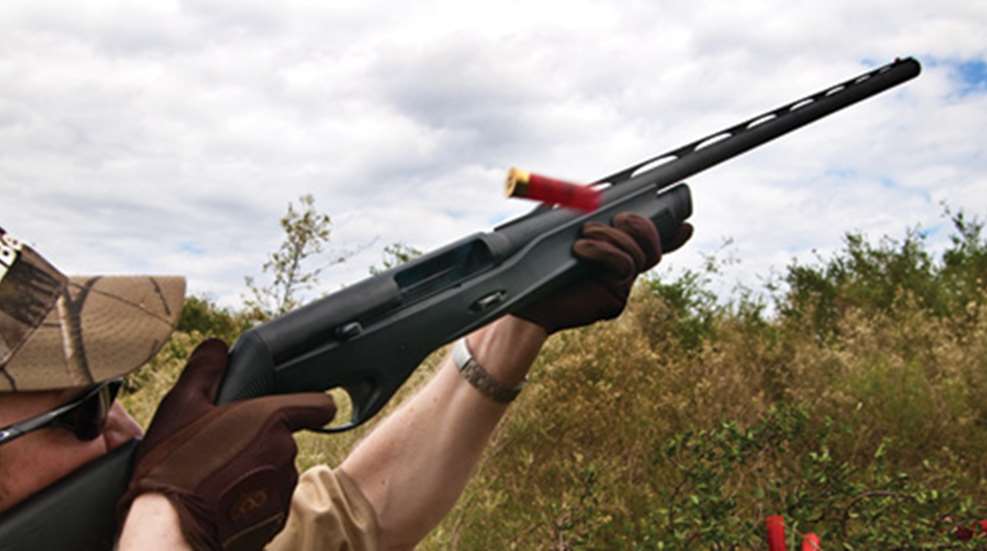
The Vinci breaks down into three parts that Benelli calls modules: a barrel/receiver, a trigger group/forearm and a buttstock. Notably absent is a screw-on magazine cap-something that's present on just about every semi-auto made since the Browning A-5.
The trigger group/forearm module includes the trigger assembly, shell carrier, forearm and magazine tube, which are all contained in one 18.75-inch polymer shell. A lug on the roof of the magazine tube is arguably the most important piece of steel in the whole gun, as it engages a recess below the barrel-sturdy insurance that the modules remain together and function as a unit.
The barrel/receiver module consists of an upper receiver mated directly to a cryogenically treated, .733-inch back-bored barrel. Despite the gun's departures from traditional design, its inertia-driven action makes it clear that within this gun lies the heart of a Benelli. Still, it had to be engineered to accommodate the modular system. The bolt's two-lug, rotating head is the same found in other semi-auto Benellis, but behind it lies a key difference: The bolt's rearward spring and corresponding guide rod compress against a plate entirely within the receiver rather than extending into the buttstock.
Due to the fact that the bolt operates independently of the stock, some soothsayers predict an extended grip, a thumbhole or even a collapsible stock will one day be available for the Vinci. That is, of course, speculation. What we do know is the Vinci has a "QuadraFit" buttstock that features the updated "ComforTech Plus" system, which consists of a smooth, friction-reducing comb, a good recoil pad and 12 flexible recoil dampeners (chevrons) in the stock. The comb and recoil pad can quickly be swapped out to adjust for fit. I snapped on a beefier recoil pad for longer length of pull-the process couldn't have been easier. Supplied shims help tweak for cast and drop.
Perhaps the biggest advantage of the Vinci's modularity is the ease and extent to which the gun disassembles. The Vinci's travel case is small and convenient. And if the old adage "If I shoot a gun, I clean a gun" means anything to you, the Vinci will definitely make life easier. White dots guide you through the disassembly (and re-assembly) process. By pressing a button under the forearm and twisting the magazine cap, the lower receiver disengages the barrel/receiver module. A 90-degree twist of the barrel/receiver unlocks it from the stock. The task takes about 15 seconds and affords access to the barrel and trigger group for basic cleaning. The Vinci's magazine tube slides out of the end of the forearm for maintenance, a subtle but noteworthy innovation. Benelli staff say extended tubes will be available in the future.
So, what's my opinion of the new Benelli? Well, I would definitely not call it a "love at first sight" type of gun. Initially, I had serious reservations about the gun's aesthetics, especially its rather bulbous trigger guard and futuristic lines. I soon learned, however, that the Vinci is a gun that must be shot for its ergonomics to be fully appreciated. I would argue that to shoot this gun is to love it. The Vinci's lower receiver is a little thick in the middle, but its bulk is in the right places; it balances between the hands, where it should. (Some shooters prefer a forward balance, but they are not to be trusted.) Handling is reminiscent of the Benelli M2. The fore-end has the feel of a slim beavertail and is one of my favorite aspects of the Vinci. It just feels "pointable."
The curvature of the pistol grip looks tight, but I found it provided sufficient room for the shooter's hand and positioned my wrist appropriately in relation to the trigger. The grip, as well as the fore-end, are adorned with "V-Grip" rather than checkering. American Rifleman Editor in Chief Mark Keefe likened its appearance to "corrugated cardboard," but it does the trick in a variety of weather conditions.
Recoil was quite negligible for a 6.9-pound 12-gauge. After putting more than 300 boxes of dove loads through the Vinci, I had a small, recoil-pad-shaped callus on my shoulder-possibly from the friction of several thousand gun mounts-but there was no bruise, no cherry on my cheek and no detachment of my retinas. My hands actually fatigued sooner than my shoulder from gripping the gun and possibly due to stock/fore-end vibration.
During the course of hurriedly loading shells, I committed a rather silly mistake several times over: sticking a shell into the magazine brass first. With some shotguns, this would have caused serious aggravation and put the hunt on hold. With the Vinci, I just pressed the magazine release button and the shell ejected before anyone noticed that I'm an imbecile.
The Vinci borrows its 4-pound, 10-ounce trigger from the Benelli R1 semi-auto rifle. Shotgun triggers are not all that important to me, because, in my experience, it takes a truly horrid one to affect wingshooting performance. That said, if a crisp shotgun trigger is important to you, the Vinci should meet your expectations.
The safety is positioned just forward of the trigger guard, a relocation reminiscent of the Winchester Model 12. My trigger finger slid to it intuitively.
As I ponder my journal entries from Argentina, one statistic in particular stands out: During just more than three days of hunting, I put 7,550 11/8-ounce, 12-gauge rounds (Estate, three kinds of Fiocchi and locally made cartridges) through the Vinci and had zero failures to feed. Those numbers ought to impress anyone.
Action Type: semi-automatic shotgun
Gauge: 12
Chamber: 3"
Barrel: 26", 28" (tested)
Sights: red fiber-optic front bread, white metal mid-rib bead, receiver drilled and tapped
Safety: trigger-guard mounted, crossbolt
Stock: black synthetic w/ "V-Grip"
Overall Length: 47¾" (28" barrel)
Stock Dimensions: length of pull-143⁄8"; drop at heel-2"; drop at comb-13⁄8"
Weight: 6 lbs., 12 ozs.
Metal Finish: upper receiver, blued steel; lower receiver, black polymer
Extras: fitted hard plastic case, five choke tubes, wrench, oil bottle, shim kit for changing cast/drop
Price: $1,379 (black); $1,479 (camo dip)













